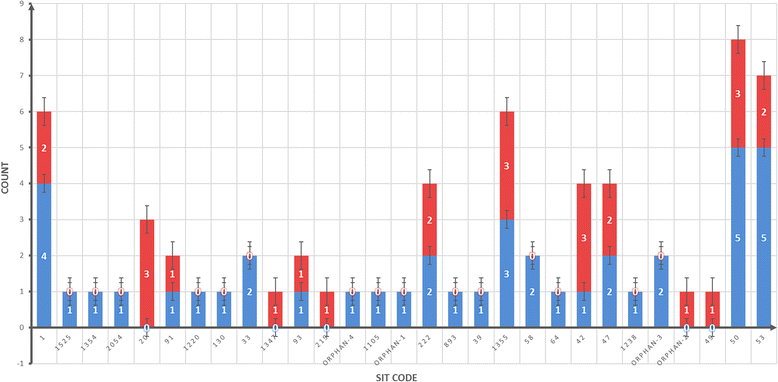A multiple genome analysis of Mycobacterium tuberculosis reveals specific novel genes and mutations associated with pyrazinamide resistance
- PMID: 29020922
- PMCID: PMC5637355
- DOI: 10.1186/s12864-017-4146-z
A multiple genome analysis of Mycobacterium tuberculosis reveals specific novel genes and mutations associated with pyrazinamide resistance
Abstract
Background: Tuberculosis (TB) is a major global health problem and drug resistance compromises the efforts to control this disease. Pyrazinamide (PZA) is an important drug used in both first and second line treatment regimes. However, its complete mechanism of action and resistance remains unclear.
Results: We genotyped and sequenced the complete genomes of 68 M. tuberculosis strains isolated from unrelated TB patients in Peru. No clustering pattern of the strains was verified based on spoligotyping. We analyzed the association between PZA resistance with non-synonymous mutations and specific genes. We found mutations in pncA and novel genes significantly associated with PZA resistance in strains without pncA mutations. These included genes related to transportation of metal ions, pH regulation and immune system evasion.
Conclusions: These results suggest potential alternate mechanisms of PZA resistance that have not been found in other populations, supporting that the antibacterial activity of PZA may hit multiple targets.
Keywords: Drugs; Efflux pump; Genes; Genome; MDR; Metallochaperone; Mutations; Pyrazinamide; Resistance; Tuberculosis.
Conflict of interest statement
Ethics approval and consent to participate
Ethical approval for samples collection and sequencing was obtained from the Institutional Ethics Committee of Universidad Peruana Cayetano Heredia and The London School of Hygiene and Tropical Medicine. Institutional approval was obtained from the Peruvian Ministry of Health. Written informed consent was obtained from all of the enrolled patients. The samples form part of a multi-center drug resistance study (
Consent for publication
Not applicable.
Competing interests
The authors declare that they have no competing interests.
Publisher’s Note
Springer Nature remains neutral with regard to jurisdictional claims in published maps and institutional affiliations.
Figures
Similar articles
-
pncA gene expression and prediction factors on pyrazinamide resistance in Mycobacterium tuberculosis.Tuberculosis (Edinb). 2013 Sep;93(5):515-22. doi: 10.1016/j.tube.2013.03.005. Epub 2013 Jul 16. Tuberculosis (Edinb). 2013. PMID: 23867321 Free PMC article.
-
Characterization of pncA mutations in pyrazinamide-resistant Mycobacterium tuberculosis.Antimicrob Agents Chemother. 1997 Mar;41(3):540-3. doi: 10.1128/AAC.41.3.540. Antimicrob Agents Chemother. 1997. PMID: 9055989 Free PMC article.
-
Non-pncA Gene-Mutated but Pyrazinamide-Resistant Mycobacterium tuberculosis: Why Is That?J Clin Microbiol. 2017 Jun;55(6):1920-1927. doi: 10.1128/JCM.02532-16. Epub 2017 Apr 12. J Clin Microbiol. 2017. PMID: 28404681 Free PMC article.
-
The paradox of pyrazinamide: an update on the molecular mechanisms of pyrazinamide resistance in Mycobacteria.J Commun Dis. 2006 Mar;38(3):288-98. J Commun Dis. 2006. PMID: 17373362 Review.
-
Mutations Associated with Pyrazinamide Resistance in Mycobacterium tuberculosis: A Review and Update.Curr Microbiol. 2022 Oct 8;79(11):348. doi: 10.1007/s00284-022-03032-y. Curr Microbiol. 2022. PMID: 36209317 Review.
Cited by
-
Cytokine and Chemokine Concentrations as Biomarkers of Feline Mycobacteriosis.Sci Rep. 2018 Nov 23;8(1):17314. doi: 10.1038/s41598-018-35571-5. Sci Rep. 2018. PMID: 30470763 Free PMC article.
-
Resistance To First-Line Antituberculosis Drugs And Prevalence Of pncA Mutations In Clinical Isolates Of Mycobacterium tuberculosis From Zunyi, Guizhou Province Of China.Infect Drug Resist. 2019 Sep 30;12:3093-3102. doi: 10.2147/IDR.S222943. eCollection 2019. Infect Drug Resist. 2019. PMID: 31686870 Free PMC article.
-
N-Pyrazinoyl Substituted Amino Acids as Potential Antimycobacterial Agents-The Synthesis and Biological Evaluation of Enantiomers.Molecules. 2020 Mar 27;25(7):1518. doi: 10.3390/molecules25071518. Molecules. 2020. PMID: 32230728 Free PMC article.
-
An explainable machine learning platform for pyrazinamide resistance prediction and genetic feature identification of Mycobacterium tuberculosis.J Am Med Inform Assoc. 2021 Mar 1;28(3):533-540. doi: 10.1093/jamia/ocaa233. J Am Med Inform Assoc. 2021. PMID: 33215194 Free PMC article.
-
Quantitative MODS-Wayne assay for rapid detection of pyrazinamide resistance in Mycobacterium tuberculosis from sputum samples.Microbiol Spectr. 2024 Nov 14;12(12):e0047124. doi: 10.1128/spectrum.00471-24. Online ahead of print. Microbiol Spectr. 2024. PMID: 39540764 Free PMC article.
References
-
- World Health Organization . Global Tuberculosis Report. 2016.
-
- Konno K, Feldmann FM, McDermott W. Pyrazinamide susceptibility and amidase activity of tubercle bacilli. Am Rev Respir Dis. 1967;95:461–469. - PubMed
MeSH terms
Substances
Grants and funding
LinkOut - more resources
Full Text Sources
Other Literature Sources
Medical



